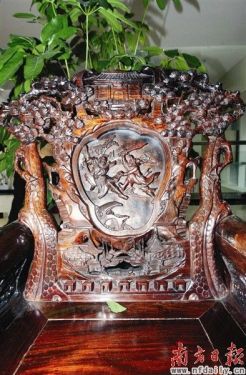 Like a statue of a respected life, it is a wide-format solid wood furniture that is nostalgic and meditation. Its introverted and subtle features are consistent with the temperament and style that Cantonese can hardly give up. In the past 10 years, the value of valuable timber has increased, and Cantonese-style furniture has once again become popular.
Like a statue of a respected life, it is a wide-format solid wood furniture that is nostalgic and meditation. Its introverted and subtle features are consistent with the temperament and style that Cantonese can hardly give up. In the past 10 years, the value of valuable timber has increased, and Cantonese-style furniture has once again become popular. The “Made-a-Artisan Residence†on Mausoleum West Road is the only store opened by the successor Yang Prawn, which has been passed down from generation to generation in the production of Cantonese-style furniture. Since 2000, the business has been booming. "Life is good and there is money. Not only middle-aged and old people, many young people are beginning to replace the old leather sofas and buy back mahogany furniture."
The traditional Cantonese-style furniture is made of high-quality wood such as rosewood, rosewood or rosewood. The atmosphere is luxurious. It once dominated the furniture industry in the late Qing Dynasty. There are three styles of furniture in the Qing Dynasty: Su Zuo, Guang Zuo, and Jing Zhong. Wide work is more representative of the Qing style. At the time, in the wooden building of the Qing Palace Office, there was also a wide wooden work to produce wide furniture for the court. Extensive furniture decoration pattern carving deeper, knife method round, fine grinding, consistent with wood, mostly made of a kind of wood, or rosewood, or mahogany, are all the same wood, never doped with other species of wood Without painting, the wood is completely exposed, giving people a real sense of what they see at a glance.
“I did not see you, this is 'Guang-style children'! Look at this material, the top is good, all 'nuclear children'!†Half a century ago, the Beijing City furniture master screams, still confirms the glory of Guang-style furniture .
According to records of the Qing Dynasty, during the Yongzheng years, many famous hardwood furniture masters from Guangdong, including Luo Yuan, Lin Bin, He Wu, Liang Yi, Lin Zhitong, etc., were called to Beijing. On the eve of the Emperor Guangxu's marriage, Guangdong's famous craftsman Liang Yi was specially called into the palace to custom-made the big wedding bed for Guangxu. For a time, Guangzhou craftsmen greatly surpassed Suzhou craftsmen in their worth and favor in the capital.
Guang-style furniture originated in the late Ming and early Qing. As a large number of Western missionaries came to China, some advanced science and technology were disseminated. Guangzhou has become an important gateway for China’s foreign trade and cultural exchanges because of its specific geographical location. Since the Portuguese arrived in China in the next quarter, their hometowns in Macau have become taller and brighter than the Portuguese. In the early Qing dynasty, Guangzhou's commercial buildings and thirteen foreign trips were successively established. Most of the buildings of these commercial establishments follow the Western style. At one time, officials and dwellings also followed suit, thus forming an unprecedented "western fever."
The craftsmen accepted the western culture and blended them into Chinese-style furniture. The revolution absorbed the human touch of the western-style furniture, and allowed the traditional Chinese furniture to be bound by dignity and a constant change to remind the Chinese furniture to be “acceptedâ€. excellent work.
After the Westernization Movement, under the influence of Western culture, attention to humanism was imperceptibly projected onto the design of Cantonese-style furniture: there was a water line at the tables and tables before the Qing Dynasty. The advantages of European-style furniture allow the table to have a gradual slope; the unique design of the "corner chair" of the wide-style furniture has changed the straight and straight drawing of the ancient chair. The handrail is curved and conforms to the structure of the human body; in order to adapt to the long southern summer, the wide The furniture also came from Yunnan, and was originally embedded in the backplane.
The Guangzhou furniture line in the Qing Dynasty was mainly concentrated on several long streets on Yanpan Street (currently near Dade Road). At that time, the facade of Qiaopan Street was “too many times Qinhuai†and the huge hardwood timber shipped back overseas was The local “shanzhai†(guild) will separate the materials for cutting, squaring, carving, scraping, and lacquering. Finally, it will be sold in two ways—exported or resold to the mainland. In the old days of Guangzhou, there was a folk saying: "Yanpan Street is an ocean of goods, Western countries are for domestic sales, and the west entrance is a bargain." It shows the industrialization of Cantonese-style furniture a hundred years ago.
During the Qing Emperor Kangxi's famous dramatist Li Yu, he sighed with emotion when he traveled to Guangdong: “To swim in Yuedong, see the devices listed by the market, half are pears and red sandalwood, and the method of production is good. It can be said that the workers are extremely skilled.â€
Workwear Coverall,Fire Retardant Coverall,Safety Coverall
Waterproof Workwear,Normal Workwear Co., Ltd. , http://www.high-visworkwear.com
![<?echo $_SERVER['SERVER_NAME'];?>](/template/twentyseventeen/skin/images/header.jpg)